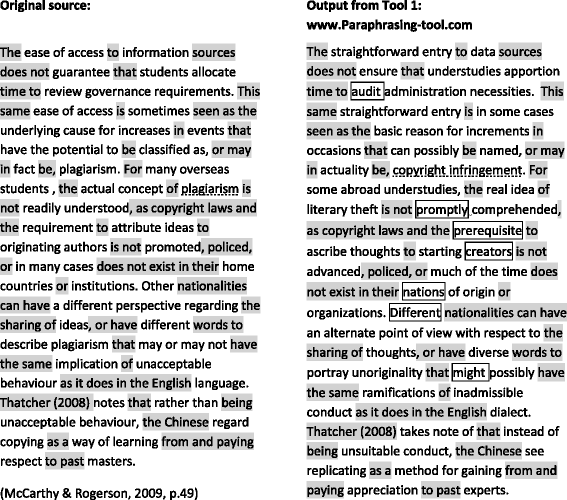You have /5 articles left.
Sign up for a free account or log in.
The thesaurus has long been a go-to tool for students looking to doll up their writing or even hide plagiarism. A recent study found that free online tools are helping students do so with entire paragraphs, and that the tools can fool plagiarism-detection software.
Co-authors Ann M. Rogerson and Grace McCarthy, two faculty members at the University of Wollongong in Australia, were made aware of the paraphrasing tools when a student asked whether they violated academic integrity policies. The student had worked on a group project, and after receiving summaries of scholarly articles that “did not make sense” from a fellow student, learned that the group member had used a paraphrasing tool.
Rogerson then revisited that student’s former assignments. She quickly realized that previous examples of clunky writing (“representative execution surveys” in the place of “employee performance reviews,” for example) weren’t the efforts of an inexperienced writer, but the work of a machine.
“Having had our attention drawn to the existence and use of paraphrasing tools, it was decided to investigate the phenomenon,” Rogerson and McCarthy write. “What became apparent was that the ease of access to and use of such tools was greater than first thought. Consequently it is important to bring the use and operation of paraphrasing tools to a wider audience to encourage discussion about developing individual writing skills and improve the detection of these emerging practices, thereby raising awareness for students, teachers and institutions.”
The study appeared in the International Journal for Educational Integrity, an open-access journal published by Springer. It was first covered by the blog Retraction Watch.
To test how effective paraphrasing tools are at evading plagiarism detection software, the authors ran a 153-word paragraph of an article they published in 2009 through two tools discovered through a Google search. They then ran all three samples through plagiarism-detection software developed by Turnitin.
The original text opens with, “The ease of access to information sources does not guarantee that students allocate time to review governance requirements.” Running it through first paraphrasing tool produced some “mainly intelligible” writing: “The straightforward entry to data sources does not ensure that understudies apportion time to audit administration necessities.” The second tool, however, churned out a garbled mess, adding contractions and random capitalizations: “Those simplicity about right with data wellsprings doesn’t surety that people dispense the long run should Audit governance necessities.”
Comparing the two paraphrased samples to the original text, sample No. 1 contained 50 percent of the same words; sample No. 2, 30 percent (click on the thumbnail to compare the original and sample No. 1).
Turnitin, which recognized that the original text had been lifted from a journal article, did not flag the paraphrased samples.
“We’re aware of this and are working on a solution,” Chris Harrick, vice president of marketing at Turnitin, said in an email. “The quality of these tools is pretty poor right now, so it’s not a big instructor concern at the moment because it is easily identifiable when students use these tools.”
(To illustrate his point, Harrick ran his response through one of the paraphrasing tools, which produced this result: “We’re mindful of this and are chipping away at an answer. The nature of these devices is entirely poor right now so it’s not a major teacher worry right now since it is effectively identifiable when understudies utilize these apparatuses.”)
But online language tools are also getting smarter. Just as Google Translate has gotten better at producing translations that sound more natural, a paraphrasing tool that uses machine learning could over time cut down on the awkwardly phrased language in the examples seen above.
In an interview, Rogerson said she was surprised that Turnitin did not flag the paraphrased text, but, she added, “You’re never going to be able to detect everything.”
Even if the tools continue to outsmart plagiarism detection software, Rogerson and McCarthy suggest there are ways to curb their use.
First of all, they write, instructors need to be open with students about the long-term implications of using paraphrasing tools. Relying on a machine to paraphrase someone else’s writing could not only hurt them academically, but also professionally in jobs where they are expected to collect information from sources and present it in their own words.
Instructors can also design assignments to encourage students to understand their arguments inside and out, the authors write, for example by requiring students to give a presentation to the class and answer questions.
Still, Rogerson said, leaving an opportunity for students to cheat at an assignment presents them with an ethical decision. “If we design everything out -- which is next to impossible anyway -- they’re missing out on that area of learning as well,” she said.








